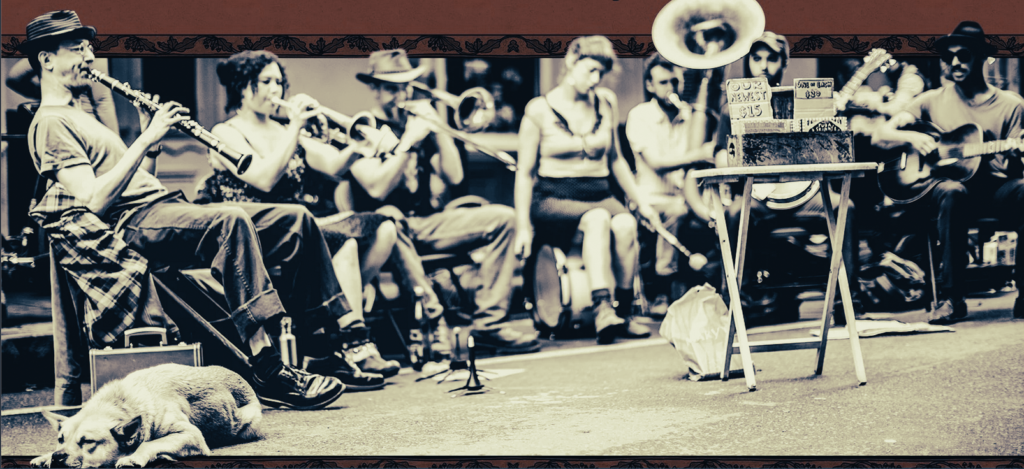
Tuba Skinny on Royal Street, New Orleans
If spiritual movements spread through the arts, and if as Swami Kriyananda predicted, Self-realization will spread “through the popular arts,” then it’s surely only a short step to wondering just how popular those arts will be.
Sometimes when my brain is toasted and seared by a morning of heads-down editing, I’ll take a break and, as a non-coffee drinker, I’ll reach for the mouse and pull up a Tuba Skinny video instead.
Which led me, recently, to speculate while singing Paramhansa Yogananda’s chant “I Am the Bubble, Make Me the Sea” during a Sunday morning meditation at the Ananda Temple in Palo Alto, that the chant would make a really fine Dixieland Jazz tune.
I was thoroughly self-amused, of course. But, really, I wonder. If marching bands in New Orleans routinely play “Just a Closer Walk With Thee,” and “When the Saints Go Marchin’ In,” it surely isn’t a great stretch to imagine that they might someday be playing upbeat Dixie-fied versions of “Bubble” or “Who Is In My Temple?”
It would be so American. Paramhansa Yogananda said that the fundamental vibration of Planet Earth is rajasic – it’s restless, active, enterprising, jumpin’ and jivin’. Nowhere more so than in America, which he said ranks among the planet’s top-two nations in spiritual inclination (the leader by a nose being India) and is self-evidently the world’s hot-footin’-est, toe-tappin’-est by a clear length. Who invented the Funny Car dragster? What country first thought it would be a good idea to put a 517-horsepower engine in a 1973 VW Super Bug? Eh? Not Europeans.
Now then, the next question is, will chanting along to trumpets, banjos, and drums be a good thing?
My first thought is: Hmm…
In Nayaswami Asha’s book, Swami Kriyananda: Lightbearer, Swamiji recalls writing the music for A Festival of Light:
Sometimes the inspiration surprised him. “When the words came—for example: ‘A fledgling bird flew out into the world…’—I paused and inwardly said, ‘Divine Mother—a fledgling bird?!’ But when something comes in this way, I don’t alter it. I followed the inspiration, and a beautiful allegory was revealed. At the point where a song was needed, these jazzy chords came that didn’t seem to fit the deep mood I was in. But as I tuned in deeper, I saw it was just right. AUM is a vibration, and the song ‘The Thunder of AUM’ expresses that vibration more than a staid melody would.”
What many people don’t know is that a Hollywood film studio offered to buy the rights to Thunder of AUM so they could use it as the theme for a Western TV series. (Swamiji graciously declined.)
The trouble with foot-tappin’ hot jazz is that it picks you up at the curb, drives you around the block, and sets you back down right where you were. Whereas chanting sets you on a path through increasingly beautiful, soul-satisfying vistas of expanding inner consciousness.
Lahiri Mahasaya said, “The only duty that has been given to man is to listen to the inner sounds.” Yogananda said that when we hear Aum in meditation, even in its first expression as a sweet unchanging sound of wind in the trees, or a soft humming, we are in actual contact with God.
Swami Kriyananda said, “Aum is everything.” He wasn’t just twiddling words. Aum is an experience, not a theology. When we attain final liberation, we merge in Aum.
So, while chants played on banjos, clarinets, trumpets, drums, washboards, guitars, and tubas are bound to be a future thing, I imagine it will be its own thing, outside of the monasteries.
The thing is, there’s a reason the saints don’t compose or perform popular music. It doesn’t match their experience. Swami Kriyananda said he somewhat resented having to write songs with spiritual themes in a popular style, and that he would have preferred to write and sing chants instead. But the need was there, and God fulfilled it through him.
It’s a question of vibration. Swamiji’s songs were composed of Aum – every note he wrote was given to him by God. His songs were meant to create a bridge that starts a far piece down the road beyond where nerve-tickling pop music ends, followed by a big gap, and then he inserted a new kind of music, with Aum at its core, that invites our attention inward and draws our awareness upward.
The music of Aum is beautiful in a soul-satisfying way. Hearing and singing Swamiji’s songs can give us that experience, if we listen with a calm, receptive heart and a quiet mind. It begins with the beauty of the notes, then we realize that this isn’t ordinary music, and then we become involved, immersed, and enthralled.
The saints tell us that Aum is enough. If you’ve ever had an experience of divine joy, you’ll know that it is everything you’ve ever been seeking; that no other desire can survive in its presence, and that you would happily invest however many lifetimes of spiritual practice it might take to get it for yourself permanently. And jazz won’t take you there.
On the other hand, who knows what might happen, when artists start to discover the inspiration of Aum?
That said, if you don’t drink coffee … Hmm …
